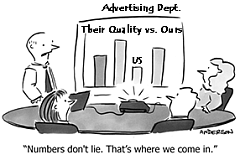In the ever-competitive world of business, advertising stands as a powerful tool to garner attention and sway consumer preferences. However, for small business owners, navigating the complex landscape of advertising can be a daunting task.
While the zeal to grow is often in abundance, a lack of experience can lead to common pitfalls that waste your time, hard-earned money, and hinder progress.
Take heed of the six common advertising mistakes detailed here and you’ll be one of the elite small business owners who leverage advertising to their long-term growth and profitability.
1. Not Testing Different Strategies
Diversification in advertising strategies is pivotal for any business aiming to thrive. It's akin to not putting all your eggs in one basket. By spreading your efforts across various platforms and methods, you essentially reduce the risk of your advertising campaign tanking due to dependence on a single channel.
Diversification allows for a wider reach as different demographics may prefer different platforms. Additionally, understanding your audience and where they spend their time can lead to more targeted and effective advertising.
Case Studies: Dollar Shave Club initially relied heavily on viral content and social media to disrupt the razor industry. However, as they grew, they diversified into TV ads and other channels to maintain their growth.
Conversely, Blockbuster, a giant in the video rental industry, failed to adapt to new advertising strategies that focused on online streaming and digital content. This lack of adaptability and diversification was a significant factor in its decline.
2. Focusing on Quantity Over Quality
In the world of advertising, the impulse to create a large volume of content can be tempting; however, focusing on quantity over quality can have detrimental effects.
When a business prioritizes churning out ads without paying attention to their relevance or impact, it can lead to brand dilution and consumer indifference.
People tend to tune out when they are bombarded with too many ads. Especially if they lack substance or fail to resonate.
Constantly pushing low-quality content can tarnish the reputation of a business, making it appear careless or disconnected from its audience.
The Impact of Good Quality Content
Quality content has the potential to not just capture attention, but also engage and convert audiences. High-quality advertisements are often more:
- Thoughtful,
- Targeted, and
- Aligned with the audience’s values and interests.
They tend to evoke emotions and establish a connection between the consumer and the brand. This connection can lead to higher engagement rates and ultimately, higher conversion rates. Consumers are more likely to trust and invest in a brand that speaks to them on a deeper level.
Case Studies: A noteworthy case study is Apple, a company known for its minimalist but highly effective advertising. Despite having the budget to produce ads in large quantities, Apple focuses on creating high-quality content that resonates deeply with its audience.
Each advertisement is meticulously crafted. Often evoking emotion and aligning the product with innovation and sophistication. This has contributed immensely to the strong brand loyalty Apple enjoys.
Conversely, Groupon had a misstep with a quantity-over-quality approach in their 2011 Super Bowl ad. It was criticized for making light of serious issues. This example shows that an ill-conceived ad can be detrimental to a brand’s image.
3. Not Utilizing Social Media
With billions of users worldwide, social media platforms offer businesses unprecedented access to a vast and diverse audience. There are just a few reasons why social media advertising is crucial, including the ability to:
- Create targeted and personalized ads,
- Engage with consumers in real-time, and
- Receive immediate feedback.
It is cost-effective compared to traditional advertising methods, making it an attractive option for businesses of all sizes. Especially small ones with limited budgets.
Case Studies: There have been numerous successful social media campaigns by small businesses that effectively utilized these platforms.
For instance, Death Wish Coffee, a small coffee company, garnered national attention with its engaging social media campaign. They used a combination of humor and customer interaction to build a dedicated following, which exploded when they won a contest for a free Super Bowl ad.
Similarly, Chubbies Shorts built a massive following on social media through humorous content and engaging with its audience. Ultimately, the company turned its brand into a well-known name in the apparel industry.
4. Neglecting the Importance of Branding
Branding, in the context of advertising, refers to the process of creating a unique identity and image for a business or product in the consumers' minds. This is achieved through a combination of elements such as:
- Name,
- Logo,
- Design, and
- A consistent theme that conveys the values and mission of the business.
Effective branding differentiates a company from its competitors. It fosters a connection with the audience, which can be pivotal for customer loyalty and advocacy.
In essence, branding is not just about visual elements. It encompasses the overall perception and experience consumers associate with the business.
Case Studies: A classic example of success through strong branding is Apple. Apple's branding strategy, centered around:
- Innovation,
- Sleek design, and
- Exclusivity.
With that, it has created a cult-like following. People don't just buy Apple products; they buy into the Apple lifestyle.
On the other hand, Kodak serves as an example of failure due to poor branding strategy. Kodak, once a titan in the photography industry, failed to adapt its brand to the digital age.
Despite having the capabilities to transition into digital photography, their branding remained anchored in the past, and they lost relevance.
5. Not Being Consistent
Consistency is the cornerstone of effective advertising. When a business maintains a:
- Steady tone,
- Message, and
- Visual identity across its advertising campaigns.
It reinforces brand recognition and builds trust with the audience. Consistent advertising acts like a glue that binds all facets of a brand together, creating a cohesive image in the consumer’s mind.
When consumers are repeatedly exposed to a consistent brand message, they are more likely to recall the brand and develop a connection with it, which influences their purchasing decisions.
Consequences of Being Inconsistent
However, inconsistent advertising can send mixed messages, which confuses the audience and dilutes the brand image. It creates a disjointed perception of the brand when the:
- Tone,
- Visuals, and
- Messaging does not align.
This lack of cohesion can lead to mistrust and make consumers question the authenticity and reliability of the brand.
Additionally, a brand that doesn’t maintain consistency might be perceived as unprofessional or lacking a clear identity, which can be detrimental in a competitive market.
Case Studies: A case study that demonstrates the power of consistency in advertising is McDonald's. For decades, McDonald's has maintained consistent branding elements, such as the Golden Arches, the "I'm Lovin' It" slogan, and a distinct color scheme.
This consistency is evident in their advertisements across various platforms and regions, and it has played a significant role in making McDonald's one of the most recognizable brands globally.
On the contrary, RadioShack is an example of inconsistency in branding. Their constant shifts in advertising strategies and brand messaging over the years created confusion among consumers and contributed to the brand’s decline.
6. Failing to Differentiate Yourself from Your Competitors
In a saturated market, differentiating your business from competitors is not just important. It’s essential.
When consumers are presented with an array of similar products or services, the one that stands out is more likely to capture their attention and, ultimately, their business.
Differentiation doesn’t just make your brand more memorable; it can also add value to your products or services. By positioning your brand as unique or superior in some aspect, you give consumers a reason to choose you over the competition.
This can be particularly important for small businesses that may not have the advertising budget of larger competitors.
Use USPs
To effectively differentiate yourself, it's crucial to identify your Unique Selling Propositions (USPs).
Start by analyzing what your competitors are offering and identifying gaps that your product or service can fill. Understand your target audience and their needs, preferences, and pain points.
Then, develop products or services that provide a solution or benefit that competitors don’t. Your USPs can be anything from exceptional quality, innovation, customer service, or even a unique brand story.
Once you've identified your USPs, highlight them in your marketing and advertising campaigns.
Case Study: A shining example of a business that effectively differentiated itself is Tesla. When Tesla entered the automotive market, it was dominated by established giants.
However, Tesla managed to stand out by focusing on electric vehicles when most competitors were still focused on traditional combustion engines. They positioned themselves not just as a car company, but as a technology and energy company, which resonated with environmentally conscious consumers.
7. Bonus: The KEY Metric You Absolutely Must Track
It’s easy to get seduced by social media marketing hype and wowed by huge potential audiences. However, the first rule of survival in marketing online of off, is to test first and make sure you are making more profit than you’re spending to get a sale before you invest heavily.
A word of caution. You’ll hear terms like click-throughs, opens, impressions, and engagement from vendors, but: You can’t pay bills with any of these.
Profit Per Sale is the only number that counts. Compare the Cost to Get a Sale (or customer if you have recurring sales) to the profit you make from the sale or the lifetime value of your customer. Track that metric and you can’t go wrong because you’ll make a profit and not take a loss on every sale or customer you generate.
Further, you won’t go broke paying for a lot of “roll out” advertising that costs you money.
Test. Test. Test. That’s the mantra of smart marketers. Fail small, adjust, try again. Repeat these steps until you find what’s making money, then start ramping up that channel. But watch the metrics like a hawk to be sure you’re putting money in your pocket and not the advertising agencies!
There are many additional factors that go into being a successful company. If you are struggling with generating sales and profits, we need to talk.
Attention Small Business Owners: Don't Make These Mistakes
Advertising is an art that, when done right, can propel small business owners into the limelight. It’s essential to understand that advertising is more than just getting the word out; it’s about creating a connection with the audience through well-thought-out strategies.
Are you looking for more help with your marketing efforts? Want to explore further? Have any questions? Get in touch and let’s set up a time to talk. There is never any cost and we guarantee you’ll leave with some great insights that will help.
Brian Tracy USA: 877.433.6225 Email Me feedback@focalpointcoaching.com














